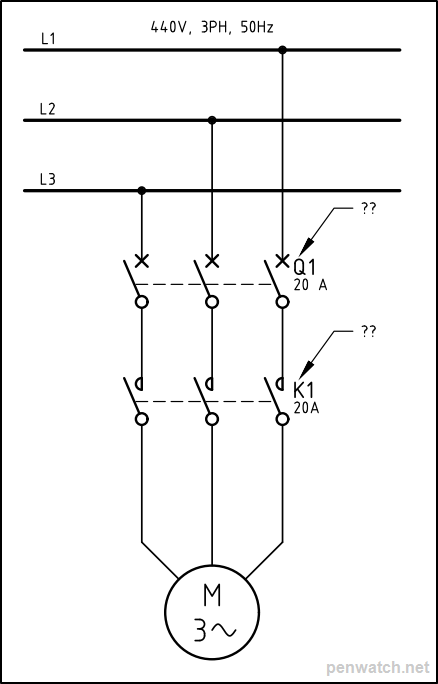Item Designations; or "Why are relays called 'K' in schematics? Why are circuit breakers called 'Q'?"
Posted: , Updated: Category: Engineering
Short answer
The prefixes ‘K’ and ‘Q’ are from standards about ‘item designation’.
Countries using European standards started out using IEC 60750, Item designation in electrotechnology. Countries using American standards use IEEE Std 315-1975 / ANSI Y32.2, Graphic symbols for electrical and electronic diagrams.
Relays are called ‘K’ because IEC 60750 and IEEE 315 say so.
This is a rare case of European standards agreeing with American standards!
I haven’t found any reason why the letter ‘K’ was used in particular. I had guessed the letter ‘K’ was assigned by a German-speaker who pronounced ‘relay coil’ as ‘koil’, and ‘contactor’ as ‘kontaktor’. Unfortunately, ‘relay coil’ translates to ‘relaisspule’ and ‘contactor’ translates to ‘schütz’. Neither of those words start with ‘K’, which sinks my theory.
Similarly, circuit breakers are called ‘Q’ because IEC 60750 says so.
IEEE 315 doesn’t agree with the use of ‘Q’ - the IEEE standard calls circuit breakers ‘CB’, which is arguably a more logical choice.
Longer answer
There are standardised “Letter codes for the designation of kind of item”.
In Australia, we use letter codes based on AS 3702, “Item designation in electrotechnology”. AS 3702 is essentially IEC 60750 with some extra information in the appendices.
AS 3702-1989: TABLE 1: LETTER CODES FOR THE DESIGNATION OF KIND OF ITEM
| Letter code | Kind of item |
|---|---|
| A | Assemblies, subassemblies |
| B | Transducers |
| C | Capacitors |
| D | Binary elements, delay devices, storage devices |
| E | Miscellaneous |
| F | Protective devices |
| G | Generators, power supplies |
| H | Signalling devices |
| J | — |
| K | Relays, contactors |
| L | Inductors, reactors |
| M | Motors |
| N | Analogue elements |
| P | Measuring equipment, testing equipment |
| Q | Switching devices for power circuits |
| R | Resistors |
| S | Switching devices for control circuits, selector switches |
| T | Transformers, voltage regulators (power) |
| U | Modulators, changers |
| V | Tubes, semiconductors |
| W | Transmission paths, waveguides, antennas |
| X | Terminals, plugs, sockets |
| Y | Electrically operated mechanical devices |
| Z | Networks, hybrid transformers, filters, equalizers, limiters |
Most of the letter codes are fairly intuitive.
- C is for capacitors.
- M is for motors.
- R is for resistors.
- L is for inductors, which is what electronics people have always used.
Other letter codes are less intuitive.
- B for transducers.
- K for relays and contactors.
- V for tubes and semiconductors. (Consider “V” for “vacuum tube”.)
- Q for “switching devices for power circuits”, i.e. circuit breakers.
There are also some strange interactions between over-lapping groups. For example, lamps are generally designated “E” for miscellaneous items. However, LEDs are both a lamp and a semiconductor, so AS 3702 Table 2, Alphabetical list of items and their letter codes, puts LEDs under letter code “V” for semi-conductors.
It appears that the later standards, IEC 61346 and then IEC 81346, attempted to make the letter codes more general. There is still some fuzzy overlap between categories. For example, IEC 81346 uses letter ‘E’ for anything that “provides radiant or thermal energy”, which includes lamps, or ‘P’ for devices which ‘present information’, like indication lamps or LEDs.
The other aspect of IEC 81346 is that it tries to cover both mechanical/fluid items and electrical items. This generalization means some of the electrical-only code letters have changed meaning, or been removed entirely. For example, inductors are now grouped into letter ‘R’ with resistors, and ‘L’ is no longer used for anything.
Historical notes
The original IEC standard was IEC 60113:1959, which was superseded by IEC 60750:1983. AS 3702:1989 derives from IEC 60750.
IEC 60750 was superceded by the IEC 61346 series (1996), which was superceded by the IEC 81346 series (2009) in turn. IEC 81346 is about 300 pages - much larger than AS 3702, which is only 24 pages! If you are only interested in the “letter codes for the kind of item”, skip straight to IEC 81346-2:2009 Table 1, Classes of object according to their intended purpose or task.
References
- AS 3702-1989 - “Item designation in electrotechnology”. Equivalent to IEC 60750 Ed 1.0 (1983).
- AS 1103.2-1982 - “Diagrams charts and tables for electrotechnology, Part 2: Item Designation” (Superseded by AS 3702-1989.)
- IEC 750-1983 - AS 3702 is equivalent, but provides extra information.
- IEC 113 (superseded by IEC 750, i.e. IEC 60750.)
- IEEE Std 315-1975 / ANSI Standard Y32.2. Annex F: “Cross reference list of Class Designation Letters” compares IEC 113-2:1971 to the IEEE/ANSI standard. Note IEEE Std 315 is a standard for both graphical symbols, and class designation letters.
- AS 1102 and IEC 60617 for “Graphical Symbols for Electrotechnology”.